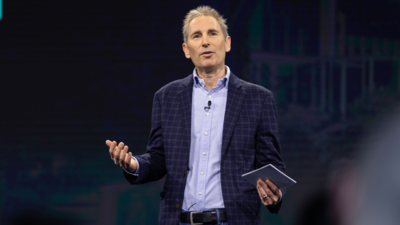ARTICLE AD BOX

Andy Jassy, CEO of Amazon
Amazon's cloud business, known as Amazon Web Services, is grappling with the same organizational bloat that CEO Andy Jassy has spent over a year trying to eliminate, according to a Bloomberg report revealing how management layers and decision-making paralysis are hindering the cloud giant's ability to compete in the AI race.The struggles at AWS come despite Jassy's highly publicized anti-bureaucracy campaign, which has generated over 1,500 employee complaints through a dedicated "bureaucracy mailbox" since its September 2024 launch and resulted in 450 process changes. Yet Bloomberg's interviews with 23 current and former AWS employees paint a picture of an organization where ideas still languish in approval cycles while competitors like Microsoft and Google ship products faster.The dysfunction is particularly alarming given the stakes: AWS remains Amazon's profit engine, but its market dominance is eroding. According to Gartner estimates cited by Bloomberg, AWS held nearly half the cloud infrastructure market in 2018 but captured just 38% of corporate spending last year. Microsoft is now growing its corporate sales backlog faster than Amazon, reversing a trend that previously favoured AWS.
Management bloat persists at Amazon Web Services despite CEO’s flattening efforts
One AWS sales engineer's experience illustrates how deeply entrenched the problem has become. Before the pandemic, he sat six management layers below then-CEO Jeff Bezos. After receiving a promotion, he checked the organizational chart earlier this year to find himself 15 layers removed from current CEO Andy Jassy—nine additional layers despite moving up the corporate ladder.Amazon defended this as an "outlier," but the fact that Jassy himself had to order a companywide mandate in September 2024 to reduce management layers suggests otherwise.
That directive required each senior leadership team organization to increase the ratio of individual contributors to managers by at least 15% by the end of the first quarter of 2025.The bureaucracy extends beyond organizational charts. Bloomberg reported that three separate AWS employees working on AI initiatives described being forced to write and rewrite project pitches so extensively "that the market moved on, rendering their ideas dated."
The delays proved particularly damaging in artificial intelligence, where OpenAI's ChatGPT launch in November 2022 caught AWS flat-footed and competitors moved quickly to capitalize on the generative AI boom.Some teams now require employees to seek permission before emailing senior executives—a stark departure from Amazon's celebrated startup culture and the flat hierarchy that helped AWS dominate cloud computing in its early years.
Current and former employees told Bloomberg this layer of formal hierarchy belies Amazon's startup ethos and slows decision-making at a critical moment.
The pandemic hiring spree's lasting damage on AWS
The root of AWS's bureaucracy problem traces directly to pandemic-era decisions. AWS went on a massive hiring spree, adding thousands of employees and creating new management layers to handle the growth. But when the company reversed course and cut thousands of jobs in a cost-cutting push, the processes and approval chains remained intact.Now AWS has fewer people but the same bureaucratic overhead. Promotions and raises became harder to secure, and teams that previously hired freely found themselves battling just to maintain existing staffing levels, current and former employees told Bloomberg. The cuts also triggered an exodus of senior talent during an industrywide war for AI expertise, with executives leading components of the AI push, startup sales, chip design, and data center infrastructure all departing.
CEO Andy Jassy's reforms show mixed results
Jassy has made eliminating bureaucracy a central theme of his leadership since taking over from founder Jeff Bezos in 2021. In his September 2024 memo announcing the management reduction plan, he wrote: "We want to operate like the world's largest startup. That means having a passion for constantly inventing for customers, strong urgency, high ownership, fast decision-making, scrappiness and frugality."The memo acknowledged that Amazon had "added more layers than we had before" during its pandemic-era hiring spree, creating problems like "pre-meetings for the pre-meetings for the decision meetings" and "a longer line of managers feeling like they need to review a topic before it moves forward."Jassy even created a "Bureaucracy Mailbox" where employees could report examples of unnecessary process. Speaking at Amazon's conference for third-party sellers in September 2025, Jassy said the tipline had received more than 1,500 reports in its first year, leading to changes in about 455 processes. At the Harvard Business Review Leadership Summit in April 2025, he said the company had already made over 375 changes based on feedback, with builders particularly frustrated by red tape that "slows them down, frustrates them, and keeps them from doing what they came here to do.
"But Bloomberg's reporting suggests these reforms haven't penetrated deep enough into AWS's organizational culture. Employees described a "frenzied atmosphere" as AWS gears up for product launches, with some teams setting aside Amazon's typical product development guidelines—skipping documentation and regular reviews—just to get products out the door before rivals.In a recent all-hands meeting, AWS CEO Matt Garman urged staffers to focus on launching products they've already promised rather than starting new initiatives, according to Bloomberg, suggesting the division has over-promised and is struggling to deliver.Amazon spokesperson Selena Shen defended the company's position, telling Bloomberg that "AWS remains the leader in cloud by a wide margin" and pointing to recent deals with Delta Air Lines,
Volkswagen
, the US General Services Administration, and State Farm. Financial results expected next week are projected to show AWS grew 18% to $32 billion, representing a modest slowdown from 19% growth the previous year.

 10 hours ago
4
10 hours ago
4









 English (US) ·
English (US) ·